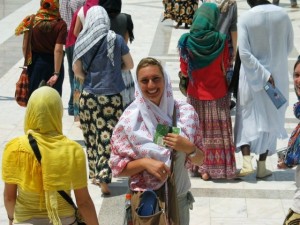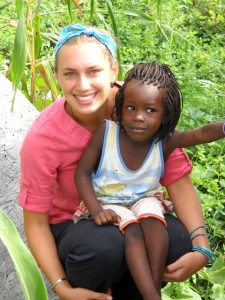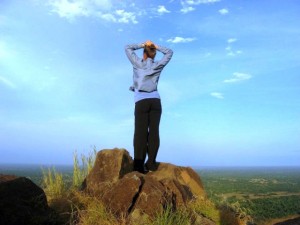 “There is something about finding yourself so completely out of your element that helps you define your own culture and your place within it. The people I met during my study abroad have redefined my definition of warmth. They were willing to help anyone at the drop of a hat, would give and give and give even if they had nothing more,” says Tatiana Logan ’13 (Santa Barbara, Calif.), who studied during the fall semester in Senegal, Africa.
“There is something about finding yourself so completely out of your element that helps you define your own culture and your place within it. The people I met during my study abroad have redefined my definition of warmth. They were willing to help anyone at the drop of a hat, would give and give and give even if they had nothing more,” says Tatiana Logan ’13 (Santa Barbara, Calif.), who studied during the fall semester in Senegal, Africa.
Through the Studies for International Training: National Identities and the Arts program, Logan took classes at a school in a developing neighborhood of the capital city of Dakar. She studied French (the official language of Senegal) and Wolof (the local language spoken by 85 percent of the population independent of ethnic group).
“I chose Senegal because I have been interested in its culture and history ever since I began taking French and African history courses,” says Logan, a double major in anthropology & sociology and global communities & the environment. “I had also been told it was an academically rigorous program that really emphasized hands-on experiences in the host cultures.”
 Her courses dealt with field research techniques and various elements of Senegalese culture including literature, history, music, gender studies, religion, and microfinance. She also participated in four four-day arts workshops focusing on traditional West African dance, djembe drumming, bronze sculpting, and Kora (African harp) playing.
Her courses dealt with field research techniques and various elements of Senegalese culture including literature, history, music, gender studies, religion, and microfinance. She also participated in four four-day arts workshops focusing on traditional West African dance, djembe drumming, bronze sculpting, and Kora (African harp) playing.
“The culmination of the semester was a month-long independent study project. Each student researched a topic of Senegalese culture on their own in any part of the country. Topics ranged from the history of the Car Rapide (colorfully painted, extremely old VW bus-like public transportation in Dakar) to studying water supply systems in rural villages.”
Her independent study was called “Bottle Caps and Hip Hop Raps: Intersections of Education, Art, and the Environment in Emerging Dakar.” The project explored local students’ thoughts, opinions, and uses of eco and recycling art and what its role is in modern environmental policy and public connections to nature.
Logan had the opportunity to travel through much of the country. This included visits to larger cities like Thies, Mbour, and Saint Louis and two village homestays: one in Mouit, in the northern coastal region of Senegal, and the other in Kedougou, the very remote, rural southeastern corner of the country.

A hike in Kedougou
“Each place was unique in its own way, but the place that really marked me was my village in Kedougou called Indar. It is a village of Bedik people who are Christian animists and have a deep connection to the land. The natural beauty and simple generosity stole my heart.”
Logan is hoping to enter a Ph.D. program in international affairs, Africana studies, or anthropology.
“I have known I was interested in international education for a while now and my study abroad experience in Senegal highlighted the fact that I would love to either teach cultural studies or work in a nonprofit international organization dealing with education,” she says. “I am really planning to see where the next wind of my life blows me; I am sure it will be neex na (a Wolof term literally meaning ‘it’s delicious’ but used in reference to things other than food as ‘super great’).”
 “There is something about finding yourself so completely out of your element that helps you define your own culture and your place within it. The people I met during my study abroad have redefined my definition of warmth. They were willing to help anyone at the drop of a hat, would give and give and give even if they had nothing more,” says Tatiana Logan ’13 (Santa Barbara, Calif.), who studied during the fall semester in Senegal, Africa.
“There is something about finding yourself so completely out of your element that helps you define your own culture and your place within it. The people I met during my study abroad have redefined my definition of warmth. They were willing to help anyone at the drop of a hat, would give and give and give even if they had nothing more,” says Tatiana Logan ’13 (Santa Barbara, Calif.), who studied during the fall semester in Senegal, Africa. Her courses dealt with field research techniques and various elements of Senegalese culture including literature, history, music, gender studies, religion, and microfinance. She also participated in four four-day arts workshops focusing on traditional West African dance, djembe drumming, bronze sculpting, and Kora (African harp) playing.
Her courses dealt with field research techniques and various elements of Senegalese culture including literature, history, music, gender studies, religion, and microfinance. She also participated in four four-day arts workshops focusing on traditional West African dance, djembe drumming, bronze sculpting, and Kora (African harp) playing.